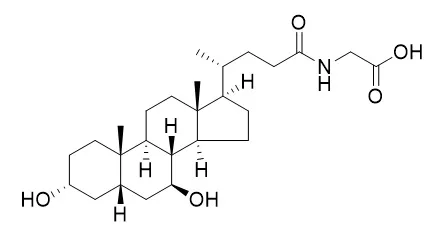| In vitro: |
| Dis Esophagus. 2010 Feb;23(2):83-93. | | Protective effects of glycoursodeoxycholic acid in Barrett's esophagus cells[Pubmed: 19549210 ] | Barrett's esophagus (BE) is a premalignant condition associated with the development of esophageal adenocarcinoma (EAC). Previous studies have implicated hydrophobic bile acids and gastric acid in BE and EAC pathogenesis.
METHODS AND RESULTS:
In this study, we tested the hypothesis that DNA damage, cytotoxicity and oxidative stress induced by bile acids and gastric acid can be attenuated by the cytoprotective, hydrophilic bile acid Glycoursodeoxycholic acid (GUDCA). Non-dysplastic BE cells were exposed for 10 min to pH 4 and/or bile acid cocktail or to pH 4 and a modified cocktail consisting of a mixture of bile acids and GUDCA. DNA damage was evaluated by the comet assay; cell viability and proliferation were measured by trypan blue staining and the MTS assay; reactive oxygen species (ROS) were measured using hydroethidium staining; oxidative DNA/RNA damage was detected by immunostaining with antibody against 8-OH-dG; thiol levels were measured by 5-chloromethylfluorescein diacetate (CMFDA) staining; and the expression of antioxidant proteins was evaluated by western blotting. DNA damage and oxidative stress were significantly increased, while thiol levels were decreased in BE cells treated with pH 4 and bile acid cocktail compared with cells treated with pH 4 alone or untreated cells. Bile acids and low pH also significantly decreased cell proliferation. Expression of the antioxidant enzymes, MnSOD and CuZnSOD, was elevated in the cells treated with bile acids and low pH. When GUDCA was included in the medium, all these effects of pH 4 and bile acids were markedly reduced.
CONCLUSIONS:
In conclusion, treatment of BE cells with acidified medium and a bile acid cocktail at physiologically relevant concentrations induces DNA damage, cytotoxicity, and ROS. The cytoprotective bile acid, GUDCA, inhibits these deleterious effects by inhibiting oxidative stress. | | Mol Neurobiol. 2015;51(3):864-77. | | Glycoursodeoxycholic acid reduces matrix metalloproteinase-9 and caspase-9 activation in a cellular model of superoxide dismutase-1 neurodegeneration.[Pubmed: 24848512 ] | Amyotrophic lateral sclerosis (ALS) is a fatal neurodegenerative disease that affects mainly motor neurons (MNs). NSC-34 MN-like cells carrying the G93A mutation in human superoxide dismutase-1 (hSOD1(G93A)) are a common model to study the molecular mechanisms of neurodegeneration in ALS.
Although the underlying pathways of MN failure still remain elusive, increased apoptosis and oxidative stress seem to be implicated. Riluzole, the only approved drug, only slightly delays ALS progression. Ursodeoxycholic acid (UDCA), as well as its glycine (Glycoursodeoxycholic acid, GUDCA) and taurine (TUDCA) conjugated species, have shown therapeutic efficacy in neurodegenerative models and diseases. Pilot studies in ALS patients indicate safety and tolerability for UDCA oral administration.
METHODS AND RESULTS:
We explored the mechanisms associated with superoxide dismutase-1 (SOD1) accumulation and MN degeneration in NSC-34/hSOD1(G93A) cells differentiated for 4 days in vitro (DIV). We examined GUDCA efficacy in preventing such pathological events and in restoring MN functionality by incubating cells with 50 μM GUDCA at 0 DIV and at 2 DIV, respectively. Increased cytosolic SOD1 inclusions were observed in 4 DIV NSC-34/hSOD1(G93A) cells together with decreased mitochondria viability (1.2-fold, p < 0.01), caspase-9 activation (1.8-fold, p < 0.05), and apoptosis (2.1-fold, p < 0.01). GUDCA exerted preventive effects (p < 0.05) while also reduced caspase-9 levels when added at 2 DIV (p < 0.05). ATP depletion (2-fold, p < 0.05), increased nitrites (1.6-fold, p < 0.05) and metalloproteinase-9 (MMP-9) activation (1.8-fold, p < 0.05), but no changes in MMP-2, were observed in the extracellular media of 4 DIV NSC-34/hSOD1(G93A) cells. GUDCA inhibited nitrite production (p < 0.05) while simultaneously prevented and reverted MMP-9 activation (p < 0.05), but not ATP depletion.
CONCLUSIONS:
Data highlight caspase-9 and MMP-9 activation as key pathomechanisms in ALS and GUDCA as a promising therapeutic strategy for slowing disease onset and progression. |
|






 Cell. 2018 Jan 11;172(1-2):249-261.e12. doi: 10.1016/j.cell.2017.12.019.IF=36.216(2019)
Cell. 2018 Jan 11;172(1-2):249-261.e12. doi: 10.1016/j.cell.2017.12.019.IF=36.216(2019) Cell Metab. 2020 Mar 3;31(3):534-548.e5. doi: 10.1016/j.cmet.2020.01.002.IF=22.415(2019)
Cell Metab. 2020 Mar 3;31(3):534-548.e5. doi: 10.1016/j.cmet.2020.01.002.IF=22.415(2019) Mol Cell. 2017 Nov 16;68(4):673-685.e6. doi: 10.1016/j.molcel.2017.10.022.IF=14.548(2019)
Mol Cell. 2017 Nov 16;68(4):673-685.e6. doi: 10.1016/j.molcel.2017.10.022.IF=14.548(2019)